Theremins… even if you don’t know the word, you definitely know the sound.
Known by musicians and non-musicians alike, as one of the strangest, creepy-sounding (cult classic) instruments known to man.
Created even before the advent of modern technology.
Think of the sound you hear when you’re watching a movie and an alien suddenly appears in a flying saucer.
Or, when a crazy character is about to finally lose it.
Well, that’s all thanks to the Theremins’ unsettling frequencies and unique timbre.
Science fiction, horror films, and, of course, music would never have been the same without it.
Now, before we get into the insanely cool, more modern aspects of Theremin’s magic, let’s first dive into its history…
Table of Contents
THE HISTORY OF THEREMINS
The Theremin was originally created in 1920 by Russian physicist Léon Theremin.
Theremin was working on a gas meter that was meant to measure the density of gasses.
As he slowly brought his hand closer to the meter, he heard a strange noise; similar to a pigs’ squeal.
When he retracted his hand, moving it closer to his body and further away from the device, he noticed that the sound got slower.
Fascinated by his discovery, Theremin then started producing melodies with strategic hand movement within minutes.
This caught the attention of his boss… who was left speechless.
From there, he invented a (freestanding) musical instrument based on his discovery.
In 1922, Theremin performed for Soviet leader Vladimir Lenin.
The following year he began touring all throughout Europe, where it caught fire.
In 1928, he brought this polished phenomenon to America.
Curious people from all walks of life attended concerts performed in major venues like Carnegie Hall.
Plus, the Metropolitan Opera house, which is where he performed publicly for the very first time (1928).
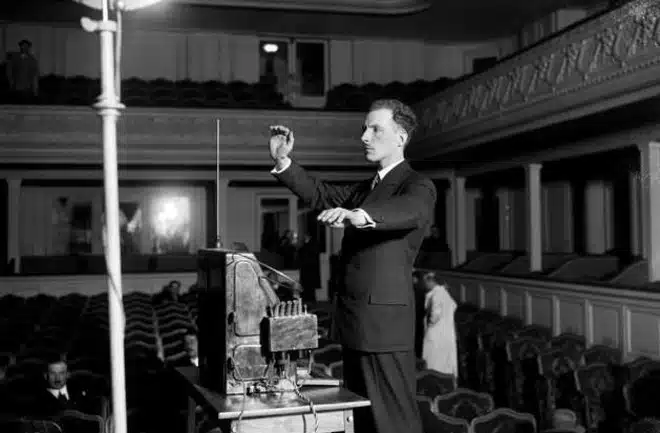
Critics were instantly intrigued and mystified, to say the least.
Having never heard anything like it before, it seemed almost magical.
It appeared as if he was pulling the music right out of thin air.
Imagine the first time you heard an ‘other worldly’ instrument, of unknown origin that completely blew your mind.
Like the ones found here.
What people didn’t know, however, was who (or should I say, what) Leon Theremin truly was.
Believe it or not, he was actually a KGB spy, sent to the USA on a mission.
That mission was industrial espionage.
So he returned to RCA (a cutting-edge electronics manufacturer at the time) to mass-produce his amazing product.
HISTORY: CONTINUED
Unfortunately, the theremin never caught on.
One of the biggest contributing factors to its demise was how RCA advertised the product.
They claimed that the theremin was easy to play, and anyone who can carry a tune was able to master it no problem.
Anyone who waves their hands in front of a theremin’s antennas can produce and alter sounds.
However, very few people can actually play it with any nuance of expression.
Let alone possess the accuracy and precision to master it.
Remember, at the time, analog synthesizers, digital instruments, or MIDI of any kind was a thing of the future.
The musicality it requires is why it remains one of the most complicated instruments for artists to play today.
RCA ceased production after manufacturing only 500 instruments total.
Out of those 500, only 136 RCA theremins were recorded to have survived.
That is why, even though RCA’s Theremin was a commercial failure, it’s still considered by many to be the ‘holy grail of theremins.’
In 1930 it was first featured in the Russian film Odna, scored by the renowned (neoclassical) composer Dmitri Shostakovich.
Since then, it has been featured in 100s of movies and has sparked thousands of amazing samples.
The theremin is instantly recognizable as the eerie, ethereal, edge-of-your-seat creepy sound that Sci-Fi dreams are made of.
Albert Hitchcock, anyone?
In 1938 when Theremin returned to his home country, he was shunned and sent to a Soviet work camp by the communist regime.
He was forced to devise spyware (including bugging tools) and listening devices.
Over the following decades, Theremin’s creation harbored a dedicated fanbase, some say ‘cult,’ and sold for almost $200 per instrument.
$2600 apiece today, to put it in perspective.
In the 1930s and ‘40s, Clara Rockmore (Theremin’s best-know virtuosa) made the instrument respected with her own unique technique.
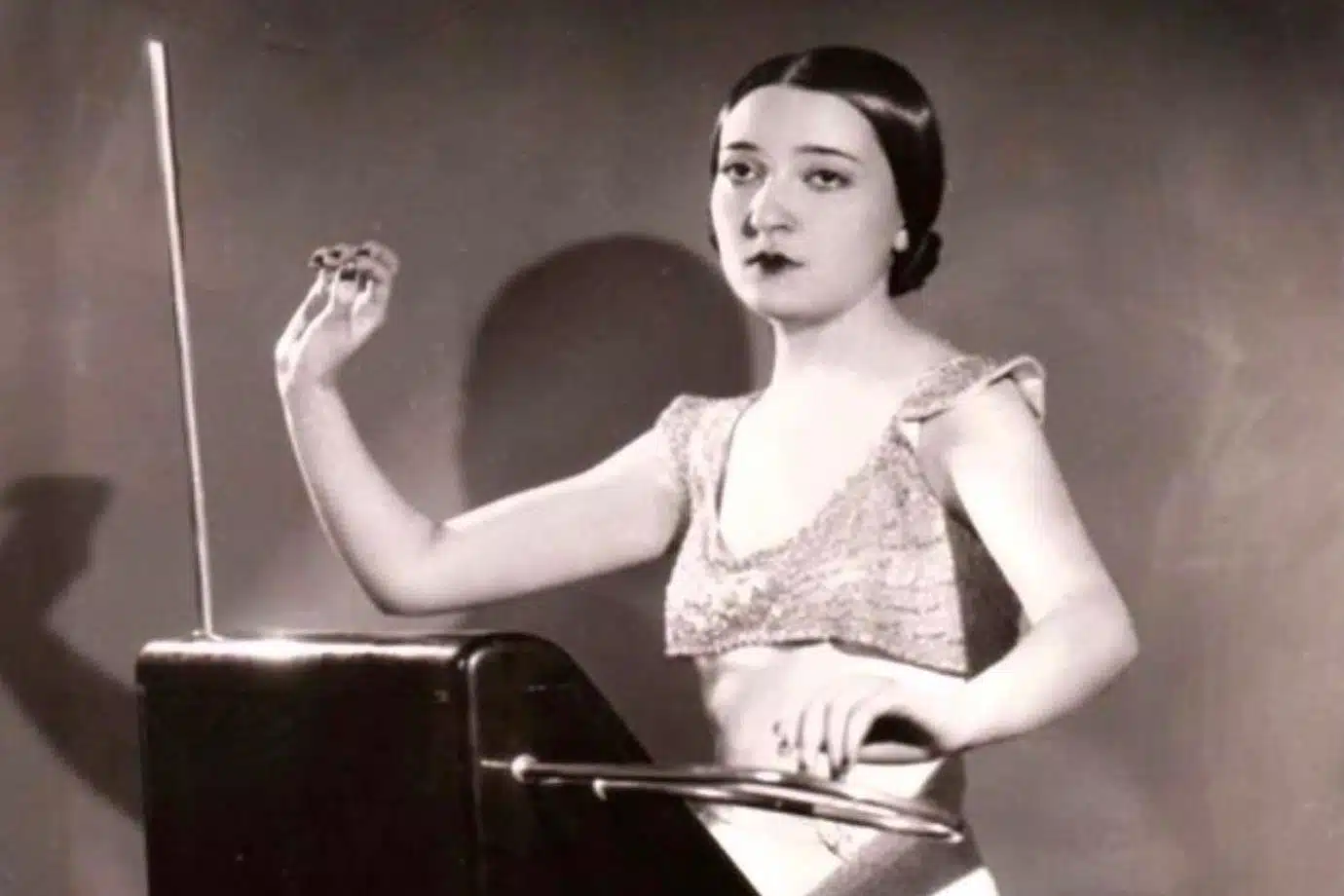
“You have to play with butterfly wings” 一 Clara Rockmore
It was she who proved it worthy of real recognition.
Shortly after, Theremin’s device caught the eye of Dr. Robert Moog, the creator of the Moog synthesizer).
He was so inspired in fact, that he actually engineered his very own theremin, at age 14, by copying drawings in the Smithsonian.
He went on to change the music landscape (or, should we say, soundscape) forever when he debuted the first commercial modern synth in 1964.
“The theremin is the biggest, fattest, most important cornerstone of the whole electronic music medium. That’s where it all began” – Robert Moog.
Moog even created the Claravox Centennial Theremin, for the 100th anniversary of the first theremin.
Which was properly named after the original theremin virtuosa herself.
It is an elite performance theremin that integrates decades of expertise; producing a once-in-a-lifetime instrument.
Pitch and scale quantization is integrated, which makes it easier to play and more practical for the modern producer.
It is fully analog, including the effects, and allows you to switch between an analog oscillator and a versatile wavetable generator.
Today, the theremin still has a very dedicated following and is featured across all music genres.
Everything from symphony concertos to pop & hip-hop.
For an instrument that originally flopped, it certainly made its mark in film and music alike.
At first glance, the theremin seems easy to play, since there are no visible notes or chords.
However, it’s (still) considered to be one of the most complicated instruments to master.
Here is why…
HOW THE THEREMIN WORKS
The theremin contains two primary circuits:
- A pitch circuit
- A volume circuit
The pitch circuit uses two tuned (radio frequency) oscillators:
- A fixed oscillator 一 generates waves at a static frequency
- A variable oscillator 一 produces a range of frequencies; it is connected to a vertical antenna
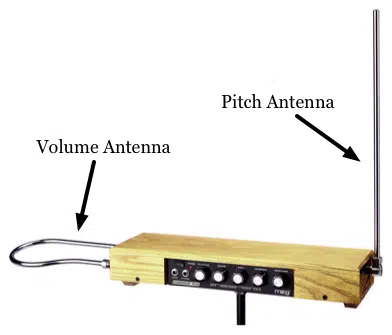
Signals from the fixed and variable oscillators are mixed together, through a process known as Heterodyning.
The frequency of one oscillator is then subtracted from the other, and the distance is amplified.
Then, finally, it is output as an ‘audible’ music tone.
The Volume circuit controls the level of the tone that the pitch circuit generates; using an oscillator that is connected to an antenna.
When you disrupt the electromagnetic field that is around said antenna, it raises/lowers the volume.
Although the theremin seems easy in theory, it takes much effort, patience, and precision to produce anything more than blats and squeaks.
Take a look for yourself…
HOW TO MASTER THE THEREMIN
A theremin operates by generating electromagnetic fields around two antennae:
- A vertical antenna 一 controls the pitch.
- A horizontal, looped antenna 一 controls the volume.
To play, you must make very small, precise finger/hand movements in the field surrounding the vertical antenna.
When you move your hand in front of the instrument (causing interference), it changes the pitch and creates melodies.
The closer your hand gets to the antenna, the higher the pitch and vice versa.
The lowest pitch occurs approximately 2 feet away from the antenna.
If you’ve ever tried to fix a fuzzy analog TV with rabbit-ear antennae, you’ve created a similar effect of the principle behind the theremin.
To control the volume, you must hover your hands (normally the left hand) over the horizontal antenna.
The true secret to mastering the theremin lies in how you control the pitch.
Flailing and jerking movements won’t get you anywhere.
Instead, you must play as if you’re drawing a song, manifesting beautiful melodies through dancing hands.
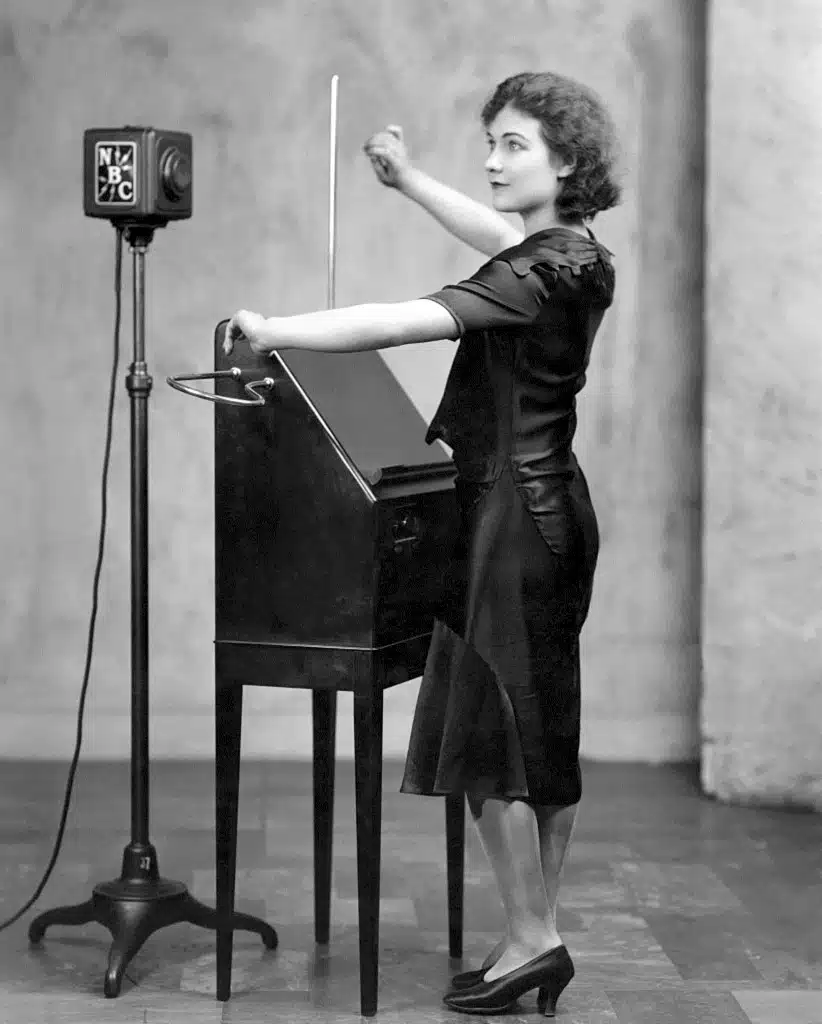
You must be tuned in fully, possess immaculate muscle control, and have keen coordination.
In order to have any theremin success, you’ve got to control the volume in conjunction with the pitch.
- Back and forth between your body and the (vertical) antenna to control the pitch.
- Up and down over the (horizontal) antenna to control the volume.
Once you’ve perfected the basic pitch & volume control (and are able to hold a melody), you can begin to incorporate vibrato and dynamics into your playing.
Although it does take some serious dedication to master, it is certainly worth the time and effort.
5 EXPERT TIPS
- 1. CONTROL YOUR RANGE
If the instrument spans 4 octaves or less, stand about a foot to 16 inches away from the instrument.
When there’s a larger range, you may be required to stand further away.
To take advantage of the full range, simply change your body position.
- 2. TUNE YOUR INSTRUMENT
In order to play in tune, you must visualize the melody you wish to convey in your mind.
Practice it slowly at first.
- 3. USE DELICATE FINGER MOTIONS
As mentioned, it’s important not to flail your hands/arms around.
Instead, make graceful, calculated movements.
- 4. STAY CONSCIOUS OF YOUR BODY MOVEMENTS
If you get emotionally invested in your performance, you may move your head or even sway.
Unlike a DJ, you don’t have the freedom to move however you want.
It can alter the electromagnetic field, and cause your music to sound off.
- 5. POSTURE IS EVERYTHING
When it comes to the theremin, your posture can affect many variables, so always try to keep a straight back.
This can also help you to avoid carpal tunnel syndrome or even tendonitis.
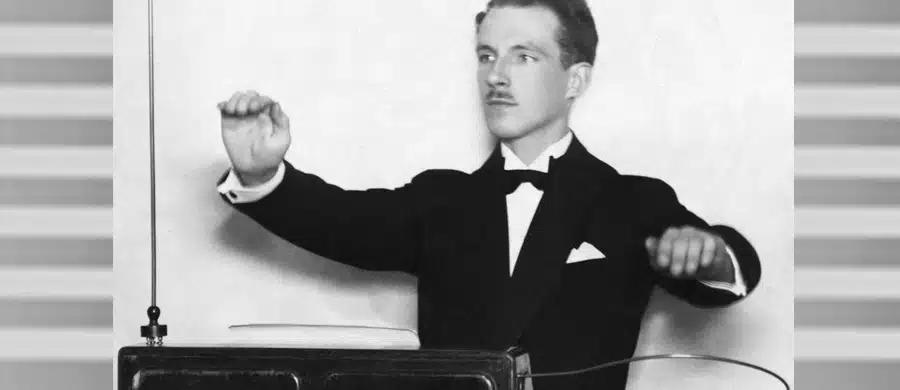
FINAL THOUGHTS
The theremin is by far one of the most intriguing, mystifying instruments known to man.
It captivates listeners instantly and remains a staple within the film/music industry even after all these years.
There’s nothing quite like when a theremin is played masterfully, and the key to being able to do so is simple:
- Practice
- Patience
- Precision
- Persistence
If you’re interested in electronic instruments and synthesizers, the theory behind the theremin is great knowledge to possess.
Speaking of electronic synthesizers, the FREE Unison Serum Essentials are undeniably the dopest, most unique pack you’ll find anywhere.
You’ll have access to the cleanest, most polished serum presets around, by professional producers with immaculate skills.
Want to tweak and customize these sounds?
No problem!
Each individual preset comes fully loaded with macros and flexible parameters.
You’ll be able to add your signature touch and blow peoples’ minds in the process.
Until next time…






